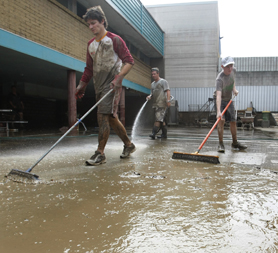Australia floods: Brisbane ‘resembles war zone’
As Queensland’s premier Anna Bligh says that parts of Brisbane look like a “war zone”, Channel 4 News’ Jonathan Miller assesses the scale of the devastation.

The devastating floods, which have swept through Queensland for weeks, has so far left 26 dead and ruined more than 30,000 homes in the state capital.
Water is beginning to recede in some parts of the country’s third largest city, but other areas remain submerged, at least 50 people are still missing, and residents are wading in water contaminated with sewage spilt from damaged treatment plants upstream.
“We have seen a massive dislocation of people across the state,” said Ms Bligh.
“Right now we are still rescuing people, we are still evacuating people. So we are right in the middle of the emergency response.”
“We are still rescuing people, we are still evacuating people. So we are right in the middle of the emergency response.” Queensland Premier Anna Bligh
Residents used pumps to remove water, and hosed down mud-strewn floors to try and stop the mud baking hard in hot sunshine. Hundreds of volunteers arrived in flooded streets to help strangers clean-up their waterlogged houses.
Parents have been told not to let children play in floodwater; snakes have been spotted amid the contamination.
“We need to brace ourselves, when this goes down and its going down quite quickly, its going to stink – an unbearable stench,” said Bligh.
“We want this mud gone out of our city as quickly as possible now: it’s a big public health issue.”
Miller in Queensland
Channel 4 News Foreign Affairs Correspondent Jonathan Miler described the scene as “shocking”.
Reporting from Queensland, he said: “Today I took a helicopter ride up into Queensland’s stunningly beautiful Lokyer Valley, where the ‘inland tsunami’ struck on Monday, after weeks of persistent rain. It was a shocking sight: houses washed two kilometers downstream, cars, trucks, littering the sprawling valley floor, where they’d been picked up by the wall of water which crashed into quiet rural communities.”
Miller spoke to an Australian disaster relief expert – Andrew MacLeod – who gave an ominous predicition that the floods which have hit Brisbane will not be once in a lifetime.
“It’s been a foretaste of the sort of natural calamaties we’re going to see more of in the future,” he said.
“It’s been a foretaste of the sort of natural calamaties we’re going to see more of in the future.” Disaster relief expert Andrew MacLeod
“Climate change is happening. Whether it’s naturally occurring or man-made. Many countries will find themselves on the frontline of wild weather – and because 80 per cent of Australians live along its coasts, this country is very vulnerable.”
“We need to respond to the fact that this is happening and in an increasingly urbanised world, we all need to be more careful about where and how we build our houses.”
Bligh and Australian Prime Minister Julia Gillard have both urged insurance companies to pay out claims to flood victims.
The Insurance Council of Australia said that at least 7,000 insurance claims worth AU$365 million had so far been submitted.
The Premier said many insurance companies don’t insure for floods so residents’ household insurance doesn’t have flood coverage “even though they have been making payments regularly and responsibly”.
Economists have estimated the flood damage at A$5 billion (£3.1bn), with $1bn (£622m) of that to be underwritten by insurers.
Mining brought to standstill
Flooding has brought the state’s coal mining industry, which fuels Asia’s steel mills, to a standstill, with more than 40 mines out of action. Many mines will take up to six months to pump out floodwaters from open pits.
Australia provides almost two-thirds of the world’s coking coal exports, with 90 percent from Queensland, and the cut in coal exports has pushed world coal prices up by a third.
The Queensland floods have been blamed on the strongest ever recorded La Nina weather phenomenon in the Pacific, which saw Australia record its third wettest year on record on 2010.
Here, Prince Charles said he would be contributing to a disaster fund set up to help flood victims.
“So many of us here in this country wanted to offer our deepest condolences to all…the families of those who’ve lost their lives in this appalling tragedy,” he said.
“We’ve all been watching with mounting dismay and concern, the appalling nature of these floods. It’s the sheer scale of them I can never get over. When you think of the metres in height of the floodwaters. We have floods here but nothing by any means in comparison to what is happening in Queensland. The sheer size of the area, the size of France and Germany together, that’s the extraordinary thing when you think about it,” he said.